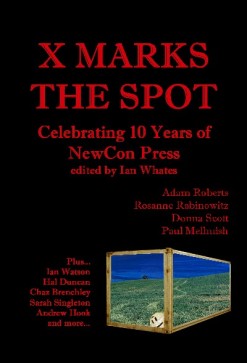 It’s been a while since my last post, to put it lightly. What can I say? Deadlines, deadlines, day job and all the usual. I should know by now that the best way to blog is to fire off quick items, otherwise you’re faced with the prospect of knitting together disparate events. But that’s life, a series of disparate items.
It’s been a while since my last post, to put it lightly. What can I say? Deadlines, deadlines, day job and all the usual. I should know by now that the best way to blog is to fire off quick items, otherwise you’re faced with the prospect of knitting together disparate events. But that’s life, a series of disparate items.
I’m pleased to announce that I’ll have a story in an anthology X Marks the Spot, published by NewCon Press to mark its tenth anniversary in July. It doesn’t seem long since I went to an event to celebrate the publisher’s fifth anniversary.
I previously published with NewCon in the anthology Conflicts. Some time ago at a bar, editor and writer Ian Whates told me he wanted stories for an anthology called Conflicts. Conflicts? You want conflicts, I’ve got conflicts! So I sent him “Harmony in My Head”, a story set around the time of the 2005 7/7 London bombings and the anti-G8 mobilisation in Scotland. Tinnitus and parallel universes were also involved.
It turned out that Conflicts (2010) was primarily a collection of military SF, which my story wasn’t, but Ian published it anyway. At least one reviewer expressed bemusement that the only military hardware in the story was a quick glimpse of a Chinook helicopter in a newspaper photo.
I’m very pleased and proud to have a story published by NewCon again, and be on board to celebrate its tenth anniversary.
Eastercon
I attended Eastercon at the end of March. It’s been my first Eastercon for several years. I felt sentimental about it being in Manchester, site of the first con I ever attended – Eastercon 1998. I went to some good panels, but now that I’m looking back over a few months and my memory is hazy I have to admit that a high point was dinner in the Greek tapas bar over the road in the company of Simon Bestwick, Nina Allen, Cate Gardner and Priya Sharma. And here’s a nice photo of myself (left) and Cate (right), taken by Cate. I’m notoriously camera-shy but I’m glad I gave in to the cajoling for a selfie. A ‘good’ photo of myself is one where I don’t look like a zombie or an axe murderer – so I think this one fits the bill.
Great God Pan – the opera
Those of you who enjoyed Helen’s Story might be interested in a forthcoming opera based on The Great God Pan. While I’ve not been an opera follower myself, I’m taking a great interest in this one. Composed by Ross Crean, the opera sets out with similar aims to give the vilified Helen Vaughan a voice. In her final aria she sings:
We will raise the living dead
Through the power of horned head,
Cloven foot and revelry.
Thus the Lord of Trickery will
Set this mortal coil on fire
With every succulent desire.
Pan is all, and all is Pan,
And we will hence return again!
Here’s a clip with some background information and music. Apparently, the production will be given a steampunk aesthetic. I really hope I have the opportunity to see it some day.
Vi Subversa (Frances Sokolov) 20.06.35–20.02.16
So now we’re going to hark back to earlier in the year… If you recall, my last blog ended with reactions to the deaths of David Bowie and Paul Kantner. Since then, we’ve lost even more creative people, including Prince, Victoria Wood and Vi Subversa.
Several months gone, I still want to say something about Vi – guitarist, singer and songwriter with feminist punk band Poison Girls. She died at the age of 80 last February.
I first went to see Poison Girls in 1980, and went to their gigs many times throughout the decade. Conway Hall, Chat’s Palace, the Cricketers at the Oval, the squatted ambulance station on the Old Kent Road, other venues with names that have long slipped away into the spaces between my brain cells.
I also remember when Vi performed at a picnic in the garden at the occupied South London Women’s Hospital in the summer of 1984. She was accompanied by one guitarist, 17-year-old Debbie Smith. I have a vivid recollection of Vi performing “Under the Doctor”, very appropriate to the hospital setting: “What I’m trying to say… is you’ve got to be strong, so strong/Because nothing takes the pain away for long!” Sadly, the garden where this took place is now a carpark for the Tesco superstore that replaced part of the hospital.
In December 2015 I went to Brighton to attend what was to be Vi’s final gig, thrilled to see her performing again. Along with her own songs she sang several Brecht & Weill compositions including “Pirate Jenny”. Her voice was perfect for Brecht. Songs such as”Old Tart’s Song” and “I’ve Done it All Before” (just about the only love song I can stomach) acquired even more resonance when sung by an 80-year-old woman. I especially liked the little polyamorous flourish she added at the end: “I’ve done it all before, but not with you… and you… and you.”
I ended up sitting across a table from Vi before she went on stage. She was talking to one of the gig organisers, then to another musician. I wanted to say hello since I interviewed her for radical women’s magazine Bad Attitude in 1995, which marked the release of a retrospective CD and a grand reunion gig at the Astoria. I also went to her 60th birthday party and had the pleasure of getting to know her a little then.
But as I sat there at the Brighton venue I was thinking: ‘Better not disturb her before she goes on stage, she might be preparing for her performance and getting into the mood… etc etc… I’ll catch her afterwards.’
But I didn’t manage to find her that night, so that didn’t happen. Perhaps she left just after her performance. And now I know it won’t ever happen.
I deeply regret that I was too stupidly shy to say hello, but I am grateful that I had a chance to see that wonderful gig. Vi Subversa was – and still is – an inspiration to me.
Here are a couple of songs from that gig, “Persons Unknown: and “Old Tart’s Song”. As you might expect, the acoustic version of “Persons Unknown” is quieter than the original, but even more powerful: “Survival in silence isn’t good enough no more…”
And here’s the original “Persons Unknown” for a bit of contrast… I believe this was the first Poison Girls record.
I’ll now share a scan of the article I coauthored in Bad Attitude. The other article on the spread is about an ill-fated UN women’s conference in Beijing, in case you’re wondering. Back in the day I suppose our prevailing aesthetic was: “We’ve got a new font and we’re gonna use it!”


If you have fond memories of any Poison Girls gigs or want to find out more about Vi and her wonderful music, you might be interested in joining a Tributes to Vi Subversa Facebook page. There you can find personal reflections and links to music videos, interviews, obituaries and tributes.
There may be trouble ahead…
Now I’m just getting up to speed. The events of the past few weeks weigh heavily, but this post is long enough. I’m sure more ranting, writing and serious thinking is called for in the near future. So at the risk of appearing flippant, I’ll close with a certain old Nat King Cole tune…








